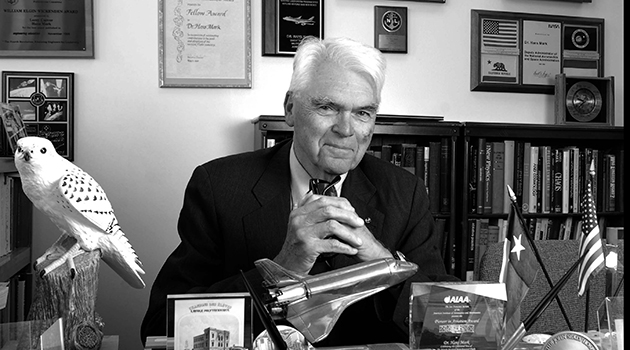
He was in mission control for the first moon landing and the first space shuttle launch, led teams that developed aircraft and space probes, pushed President Ronald Reagan to adopt the Space Station program and is still pushing to this day for a manned mission to Mars.
Mark, the John J. McKetta Centennial Energy Chair in Engineering at the Cockrell School of Engineering, says exploration and discovery is in our DNA. “To explore is an essential part of life, and a great nation has the obligation to explore,” he said.
When Mark joined The University of Texas System, he dedicated his work to developing UT’s scientific and technological prowess. Now, after a distinguished career that spans six decades, the beloved Cockrell School of Engineering professor will retire this summer.
With his innovation and leadership in nuclear physics, space technology, national security and higher education, Mark’s legacy of exploration and discovery will continue to inspire the university community, the state of Texas and the United States for decades to come.
The Early Years
Mark was born in 1929 in Mannheim, Germany, and as a young boy he witnessed violent clashes between fascist and communist gangs and saw his Jewish father imprisoned for advocating Nazi resistance. A bribe and his father’s expertise in synthetic chemistry (he is now known as the father of polymer science) secured him and his family a home in the U.S.
In 1947, after growing up in New York, Mark went to the University of California, Berkeley, with dreams of working with Ernest Lawrence and Robert Oppenheimer, key figures in the development and creation of the atomic bomb that brought World War II to a decisive end.
"I badly wanted to join this group of people and learn the new technology that had such a profound effect on the outcome of the war," Mark said.
Mark would have his chance in 1955. After receiving his undergraduate degree in physics from UC Berkeley, marrying fellow Berkeley student Marion "Bun" Thorpe and earning his Ph.D. in physics from MIT, Mark returned to California to conduct nuclear weapons research at Lawrence Livermore Lab.
It is through advanced technology that Mark thought the United States could win the Cold War — the primary objective of his work between the 1960s and 1980s.
The NASA Years
Mark's career would shift from academic nuclear research to government aeronautics and space development starting in 1968, when he was asked to direct NASA’s Ames Research Center. It would continue to be his main focus when President Jimmy Carter appointed him to Secretary of the Air Force in 1979, and when President Reagan appointed him to Deputy Administrator of NASA in 1981.
Throughout his years with the government, Mark also served as Director of Defense Research and Engineering and Director of the National Reconnaissance Office. All of these positions sometimes made Mark privy to secret technology used for spying and striking, and at other times had him overseeing the highly publicized probes and rockets of the Space Race.
One of his great missions of discovery at the time was the development and launch of the first manmade object to leave the solar system, the Pioneer 10, a space probe that the NASA Ames lab designed to fly past the asteroid belt, Jupiter and Saturn to collect data and images. The Pioneer 10 also carried a special message from Earth, thanks to some under-the-radar tinkering from Mark, and astrophysicist Carl Sagan.
Mark’s major scientific accomplishments include contributions to the development of X-ray astronomy, more accurate atomic wave functions and various fields of nuclear instrumentation.
In the final years of the Cold War, Mark decided to return to academia, and in 1984, he became chancellor of The University of Texas System.
The Texas Years
Mark had three big goals for the university system: increase research funding, attract economically lucrative technology companies to Austin and cultivate a strong relationship with Texas’ growing Hispanic population. By the time he left the position in 1992, Mark had doubled the UT System’s research budget, helped bring microchip consortium SEMATECH to the city, and established The University of Texas-Pan American, located on the Texas-Mexico border.
Mark is known for the personal approach he brought to the UT community as chancellor, opening up the historic residence of UT’s chancellors and hosting dinners and events in his home for faculty, staff and students.
After his chancellorship, Mark divided the rest of the 1990s between teaching courses at UT Austin and advising in Washington, D.C., on space research and engineering. But since 2001, Mark has been an integral and consistent part of the Cockrell School community and of the undergraduate aerospace engineering experience, having made teaching the program’s introductory class his main priority.
"I teach them aerospace, and then I tell them jokes," Mark says.
But it’s likely that Mark has had much more of an impact than perhaps he even realizes. The expertise, perspective, ingenuity and humility that he has brought not only to the fields he worked in, but also to his relationships with the people who helped him along his journey, have helped make him a true champion of technological superiority — a label that will continue to be attached to Hans Mark long after his retirement.
Hans Mark Scholars Endowment in Engineering Honors
In honor of Hans Mark's legacy of dedication to engineering students at UT Austin, former students and friends have launched an effort to raise $1 million to establish the Hans Mark Scholars Endowment in Engineering Honors. This endowment will provide full tuition to the best and brightest undergraduate students for generations to come. For more information, visit the endowment page, where you can find information about making a gift to the Hans Mark Scholarship.







